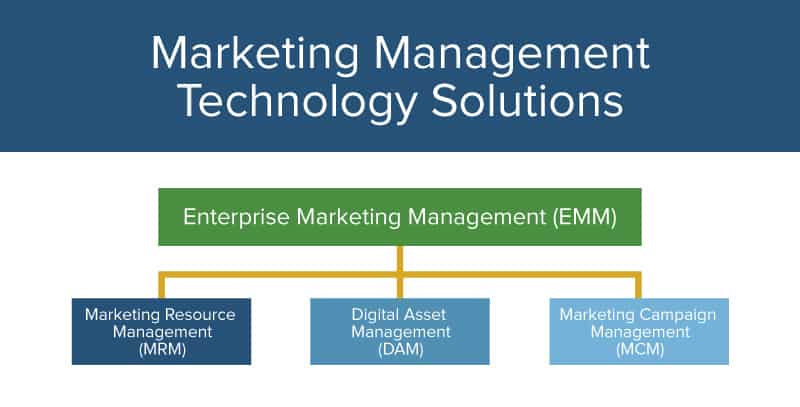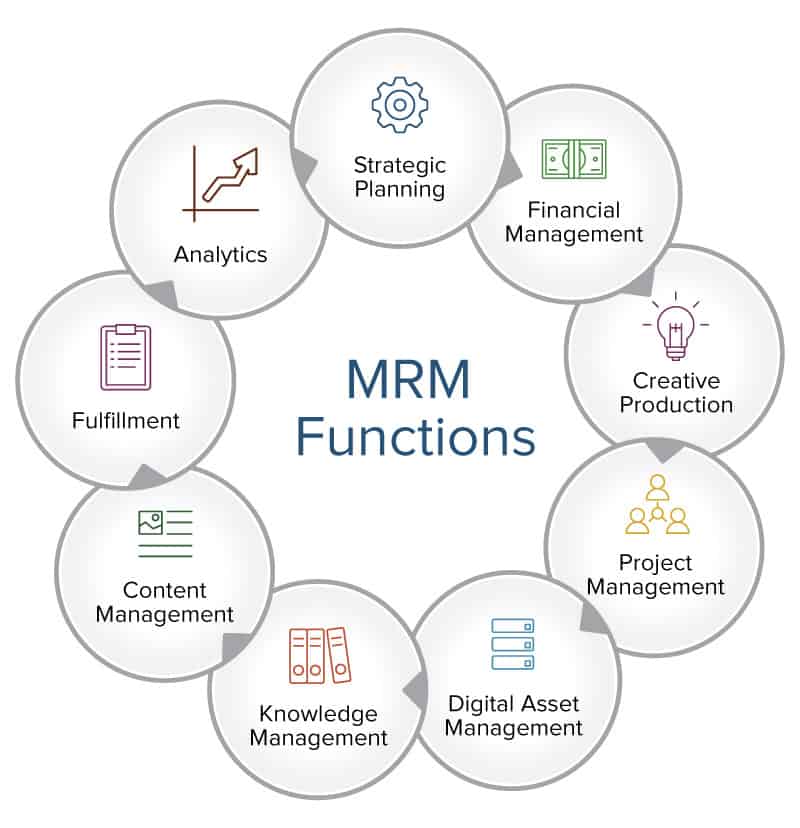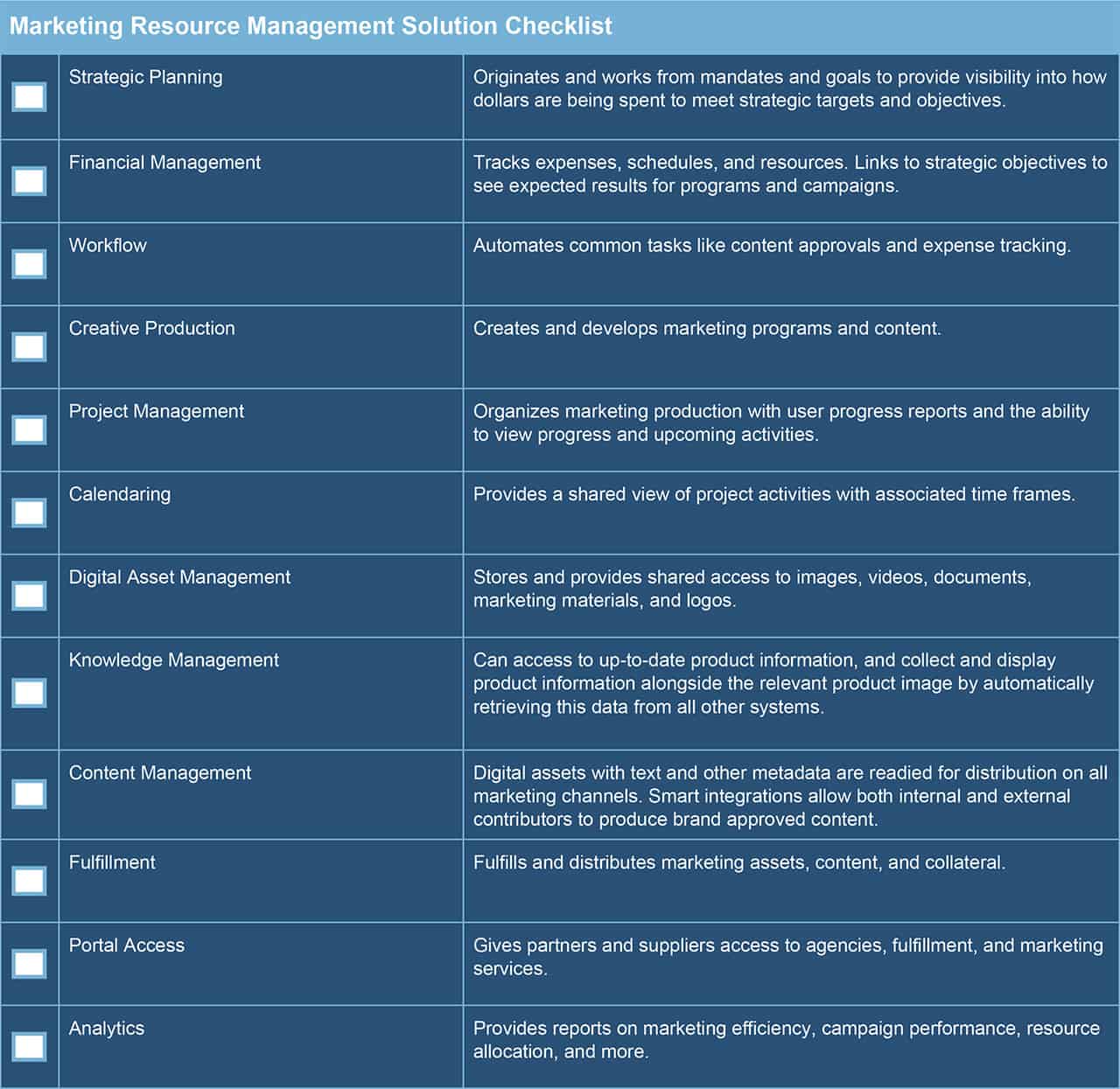What Marketing Resource Management Software Is and Isn’t
The marketing landscape is more complex than ever before. The consumer is driving demand for when, where, and how they will engage with your brand, so marketers must take full advantage of new media channels, segmentation strategies, and capabilities. That all creates a high volume of work that also needs to be completed at an ever-increasing pace. Marketing executives are looking into marketing resource management (MRM) solutions to keep up with escalating demands on people, time, and budgets, all in an effort to bring order to what can be a chaotic endeavor.
So what is MRM? It’s software that helps users manage marketing processes so companies can be more agile in planning, management, and execution on marketing programs and campaigns, all while maintaining a consistent brand image across marketing and communication channels. An MRM system usually provides planning, budgeting, and tracking capabilities, as well as tools for managing digital brand assets, workflows, and approval processes.
In a digitally-driven world with evolving customer journeys, are MRMs the answer to increasing speed-to-market and meeting heightened consumer demands? To help us explore the current and future state of MRM, two experts provide their insights:
“The definition of MRM is indeed quite ambiguous and has yet to truly be defined from my own experience,” says Andersen. “When we take a closer look, we see that the broad concepts that lie within MRM are still in their infancy. It is then easy to see why there is no clear definition. You have some MRM systems that encompass ALL or most of the capabilities, like Kapost and similar platforms. They are both Digital Asset Management (DAM) as well as Marketing Campaign Management (MCM), concentrated within their marketing segment.”
Marketing resource management got its start when enterprise-sized organizations needed a way to coordinate global marketing activities using expensive on-premise systems. Thanks to the option of SaaS delivery, MRM is now available to companies of all sizes. It’s also possible to buy modules to integrate with tools already in use.
Defining MRM Structure and Terms
The market has evolved over the last decade, and there has been a proliferation of terms around marketing management technologies and how they work together. As functionality expands and products are developed, the boundaries between software solutions continue to blur as MRM solutions incorporate other technologies. Let’s put the pieces into perspective to see what MRM is and isn’t:
MARKETING MANAGEMENT TECHNOLOGY SOLUTIONS
- Enterprise Marketing Management (EMM): This supports every aspect of the marketing supply chain through a combination of technologies.
- Marketing Resource Management (MRM): Also known as Marketing Operations Management (MOM), this is the software infrastructure that aligns people and processes with technology in support of marketing activities to improve marketing effectiveness.
- Digital Asset Management (DAM): Software that organizes, stores, and retrieves rich media and manages digital rights and permissions.
- Marketing Campaign Management (MCM): Software that handles the various aspects of direct marketing campaigns from planning, execution, and tracking through final analysis.
Marketing Resource Management (MRM) is being explored by companies of all sizes because it promises to help improve efficiency, reduce costs, optimize resources, and drive more effective marketing programs by automating and streamlining day-to-day operations. But is it delivering on the promise of bringing order to marketing chaos?
Are MRM Software Platforms Delivering on Their Promise?
"Like any other business management stream, marketing and advertising face the issue of effective resource planning and management,” says Keswani. “First put into practice in the 2000s, MRM software has been offering businesses and marketers help in terms of operations management, creative planning and production, channel and funnel management, communication and collaboration as well as budgeting. But as the penetration of digital grows into business’ marketing and communication activities, MRM software is, unfortunately, falling behind expectations and as a result, may not necessarily cut through the ‘must-have’ lists of the marketers.”
Speaking from the vantage point of his global practice, Keswani adds, “This is especially true with the multinational companies who have their marketing departments spread across different regions and time zones. Today, there are so many open source and free automation software options available which can even be micro-personalized according to each marketing department’s needs, such as the creative team, the analytics team, the sales team, etc.”
What Benefits Should Marketing Resource Management Deliver?
The main objective of today’s marketing should be to connect more powerfully with individual consumers. Businesses must understand their customers and prospects, use data to continuously learn and adapt, move fast, and enable a single, unified system across every channel. What should MRM deliver in light of these challenges?
- Usability: Whether it’s one system from a single vendor or a solution consisting of various modules or plug-ins, it must be simple to use. Some offerings require an enormous amount of training, and some MRM technology can be overwhelming for non-tech types.
- Brand consistency: Even if colleagues are countries apart, MRM should make sharing - and therefore consistency - easier to achieve. Many systems provide administrator control, too, to manage who can access materials and what functionality is available to individual users. When channel partners are using the system, this control is a benefit, because it can restrict or automatically customize based on brand guidelines.
- Shorter cycles: Many businesses support multi-channel marketing in separate departments. You can speed up production time by unifying processes, having shared repositories, eliminating redundancies, and automating multiple functions like approval procedures and language translations. Speed also creates a competitive advantage because you can react appropriately to market events.
- Flexibility/adaptability: If you have legacy systems you want to keep, it’s important to be able to integrate them into a larger MRM. You also want to be able to adapt and change to reflect what you learn. For many businesses, it may be important to bring on new modules one at a time to try them out and see what works and what doesn’t.
- Reduced costs (therefore upping profits): By standardizing processes and streamlining workflows and communication, you save time and labor. You also can optimize marketing investments armed with insight into past performance.
Keswani shares the number one concern: “If the MRM software providers want to ensure an enduring future for their products, then they need to be able to adapt with the changing times and evolve their offerings into a single centralized operating system, which leads the other business departments by example. It should help to grow revenue, brand as well as people."
How Are All These Benefits Delivered?
The ability to automate and streamline key marketing processes with consistency over brands and regions - or even at one company - is a benefit to marketers who are already juggling many tasks. The ability to measure the impact of campaigns whether they are produced in-house or by an agency means you can pinpoint where and how ROI is generated, and make strategic changes when and where they’re needed. A MRM white paper by Aquent states, “Our calculations show that companies using an MRM solution typically achieve the same marketing results with: one-third fewer internal resource costs, one-half the agency spend, one-eighth reduction in media, production, and materials spend…all without losing marketing effectiveness.”
In its Magic Quadrant for Marketing Resource Management, Gartner states, “The gaps between vendors appear to be widening, due largely to differences in their product capabilities and market execution. Judging from the vendors that Gartner tracks, we estimate that there are over 6,300 MRM implementations worldwide in midsize and large companies, which collectively generate over $1 billion in annual revenue.”
Why Adoption is Slow, Despite the Benefits
While all of those benefits sound great, there are barriers to MRM investment. In her practice, Andersen says, “I have found that adoption rates are slow to rise due to the fact that companies are reluctant to add new MarTech-related tools to what they are already using and implementing – almost out of fear of overwhelming their staff with too many tools and systems. Many marketing departments are reluctant to change. Another factor that could be relevant is that gaining the proper approvals can often be challenging and time-consuming for marketing leaders within enterprise-level organizations.”
Factors hindering adoption:
- Marketing is seen as a cost center: Marketing is often not the first place businesses spend on technology (or on anything else) because executives may not see fast, measurable results as they do with spends on the sales side. There’s still an investment to be made, even with SaaS.
- Comfort with the status quo: The ultimate decision makers at the executive level may not have an insight into the day-to-day challenges of their marketing organization, and think that everything is working, despite inefficiencies.
- Implementation hurdles: Adopting an MRM system requires a dedication to change management and a dedication to best practices. Systemic changes always take time, and in times when speed is essential, it may seem like any possibility of downtime is a non-starter and risky.
In Gartner’s study of key market players, Magic Quadrant for Marketing Resource Management, their research confirms that implementation times can be long. “Implementation times (to full production deployment) ranged from three to 16 months among the reference customers, with the average being eight months.”
Keswani sees other challenges. “While cost is a major challenge to MRM systems adoption, there are other reasons. With MRM, the user interface (UI) is sometimes limited to only certain types of devices. This means that not all of their features are mobile-responsive, which is the need of the hour. The users don’t like to be slowed down because of such UI-related limitations. Another shortcoming is the lack of integration abilities with other third party marketing systems.”
Support is another issue. “Support is only through formal support channels. While it is good, sometimes you have to face longer call queues, especially when there is a new update which may need extensive training upon implementation,” says Keswani. “Whereas, the open source software usually have user-led communities or open forums, which are faster in response and have a user-level feedback rather than a business-level feedback. When you post your request on such forums, other users who might have faced such issues can help you out of their personal experiences, which is generally more useful.”
The Future of MRM - It’s Not Dead, Just Morphing
According to Andersen, MRM isn’t dead - in fact, it’s on the upswing, with no end in sight. “I would absolutely say that the world of MRM software is really just beginning. While we have large companies such as Marketo and Infusionsoft, we also see a plethora of new MRM providers arriving onto the scene. A good example of a newer solution is Market Hero, which has proved to be an invaluable MRM product pioneered by a seasoned online marketer who saw an immense need for an improved toolset.”
Despite the questions caused by market leader Teradata selling it’s MRM Aprimo at a huge loss, market conditions for MRM look good and forecasts are positive. The global marketing resource management market is predicted to grow and be worth $9.01 billion by 2020, and much of that can be attributed to entries in the market of cloud-based MRM and the increased adoption of digital by consumers and marketers.
How is MRM sold since sales are on the increase? “Since possible ROI is so personalized to each business, MRM sales staff find themselves selling more on the convenience and functionality than they do on possible ROI and hard numbers,” says Anderson. “With many MRM providers now offering seamless integration with advanced CRM systems, it is absolutely possible to have both working together in a manner that contributes to a marketing team’s working knowledge of key metrics and KPI’s.”
Markets and Markets Global Forecast states, “The major driving force for the MRM software market is the increased consumption of digital media and substantial adoption of mobile devices, growing Internet consumption, along with the increasing overall time spent by the users online. In the past, consumer goods and the IT & Telecom vertical were increasingly adopting MRMs in the face of fierce competition, along with providing assistance for management of vast digital content...Traction for a MRM solution across other verticals such as government has substantially grown...The trend is expected to continue leveraging MRM solution vendors to offer more advanced and superior solutions with CRM and ERP integration, and mobility as a prime constituent for empowering contemporary MRM solutions.”
The Open Source Challenge
Even with these forecasts for an expanded market, Keswani sees open source tools as a challenge to solutions for purchase. “Open source solutions are a competition for MRM tools,” Keswani says. “While MRM software does offer a single-system (what we call a one-stop-shop), it is also its limitation. As the consumers’ technology needs are advancing, the MRM software systems need to be able to adapt themselves according to these changing needs. However, since the API (application programming interface) may not be openly available, such modifications and personalization are limited with MRM software.” It’s all about flexibility, adds Keswani. “Whereas, for open source tools, one can do as many integrations as possible because of open API infrastructure. This means that you don’t have to depend upon their customer support team for any minor change or addition to the software and your internal IT team can work with the marketing team to implement such changes.”
Whether on-premises, in the cloud, open source or some combination, every marketing organization within businesses or agencies needs to be able to manage their marketing resources.
Capabilities to Look for in Marketing Resource Management Tools
To determine what you need and what will work for your organization, you’ll first need to identify your pain points and what your MRM system needs to deliver, whether you purchase a soup-to-nuts system or slowly add modules. Here’s an overview and checklist of functions and capabilities to use as you begin your search.
MRM Functions and Capabilities
MRM System Solutions Checklist
Not every MRM platform offers every capability. This checklist can help you assess what you need in an MRM, and whether or not you want to integrate an application your business currently uses. A system that provides all of these functions and capabilities would be best-in-class:
Download Marketing Resource Management Solution Checklist - PDF
A word for all MRM seekers comes from Andersen: “My advice to all of my clients is always to demo an MRM solution, and thoroughly test it out before committing and undertaking a large user adoption effort across their organization. By taking the time to test all of their MRM options, they will be able to make a better-informed decision from the start.”
Improve Resource Management Efforts with Smartsheet
The best marketing teams know the importance of effective campaign management, consistent creative operations, and powerful event logistics -- and Smartsheet helps you deliver on all three so you can be more effective and achieve more.
The Smartsheet platform makes it easy to plan, capture, manage, and report on work from anywhere, helping your team be more effective and get more done. Report on key metrics and get real-time visibility into work as it happens with roll-up reports, dashboards, and automated workflows built to keep your team connected and informed.
When teams have clarity into the work getting done, there’s no telling how much more they can accomplish in the same amount of time. Try Smartsheet for free, today.




